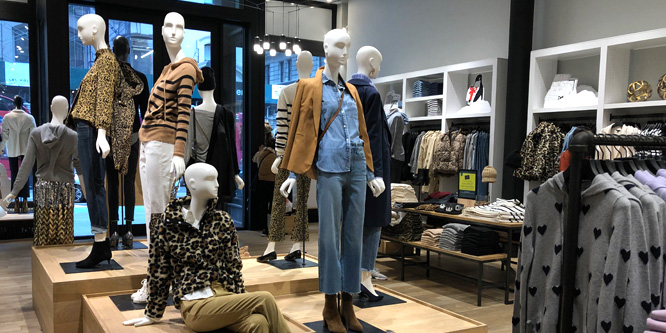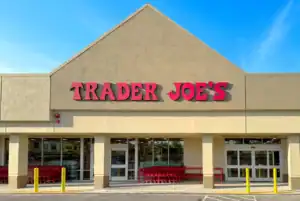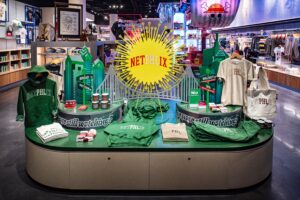
Photo: RetailWire
April 14, 2020
Has COVID-19 turned fashion into an endangered retail species?
Through a special arrangement, presented here for discussion is a summary of a current article from the blog of Nikki Baird, VP of retail innovation at Aptos. The article first appeared on Forbes.com.
Outside of travel and leisure, no industry will be more affected by the COVID-19 pandemic than non-essential retail, and in that category, no vertical will be impacted more than fashion.
The only apparel that could be argued to be essential might be kids’ clothes and maternity wear. Kids and bellies grow. Everything else can wait.
Fashion isn’t going to come back fast, either:
- All the wrong inventory. Everything stuck in stores right now is pre-Easter. That all has to go in order to make room for summer, back-to-school and even winter seasons.
- Hard-to-get quantities of the “right” inventory. The supply chain is frozen, with retailers canceling brand orders and brands canceling factory orders. Key production centers such as Indonesia and Malaysia are just feeling COVID-19’s impact. Cash flow crunches all along the supply chain, coupled with wild uncertainty for the future of demand and supply, means brands have to operate very conservatively. Yet if too conservative, will they have anything to refuel the cash tanks during the holidays to power the spending they need to make in 2021?
- Distribution channels at risk. Department stores like J.C. Penney and Macy’s were already in precarious shape pre-pandemic and any major exit will put more pressure on other retailers’ ability to clear old inventory. Some brands haven’t taken direct-to-consumer seriously, and that will have to change — and fast. If the wholesale market for fashion collapses, how much time will they have to ramp up a direct-to-consumer model on the scale to make up the difference?
To compound these issues, staggering unemployment figures mean discretionary income just took an enormous hit. Most fashion brands are also too large to qualify for the paycheck protection program, and other relief for them has yet to be defined.
A vaccine, a surge in testing and aid programs that additionally bolster consumer spending may yet offer some hope. In the meantime, however, just like you’re buying takeout to help support your favorite restaurant, buy something if you can from a fashion brand you love. They may not make it past this next holiday season.
Discussion Questions
DISCUSSION QUESTIONS: How will the pandemic reset the fashion marketplace? What particular challenges do fashion brands that rely on traditional wholesale channels face in their recovery efforts?
Poll
BrainTrust
Paula Rosenblum
Co-founder, RSR Research
Shikha Jain
Partner, Simon-Kucher & Partners
Recent Discussions







Sadly, I believe that many marginal apparel retailers will simply not be able to re-open. Furthermore, I believe that apparel retailers will be one of hardest hit of all the retail categories. One of the key challenges apparel retailers will have is shopper demand. Even on the other side of COVID-19, many predict that consumer demand will be stunted for a significant period of time due to the high unemployment levels. Retailers can blow out last year’s apparel, but you need customers who are willing to buy, and I think that’s going to be the biggest challenge.
The fashion marketplace will shrink as a result of the pandemic. Some designer houses will not survive this event. Some may have to shrink first to survive and try to surge later. The demand for fashion will still be there on the other side of this but with few providers to start.
I just read an article in WWD that sales of fashion apparel online were up 55 percent globally over the last couple of weeks. Much was due to steep discounts, but there is also the glass-half-full point of view that there is a glimmer of some pent up purchasing and perhaps a little bounce back in store for the industry.
I completely agree that fashion will be the most distressed sector of retail as a result of this crisis. The segment went into this with a whole raft of problems which are now being exacerbated. The casualties will be enormously painful but, in some ways, necessary as overcapacity has haunted the sector for too long.
In terms of wholesale, any brand still relying on department stores to distribute product has clearly been out of touch for too long. The whole channel is a hot mess and the writing has been on the wall for many years.
I believe that off-price retailers are positioned well for life after COVID-19. Last season for them is not a problem and they should prosper once we can get people into stores again. Fashion brands face a serious dilemma. Do they pack away this year’s product for next, mark it down, or sell it to off-price? None of these choices are palatable but the retailers must do something to survive. Those that do will need to change their business model. They need to tighten up the supply chain, look to on- or near-shore sourcing options, move to BOPIS/ghost/dark store concepts and emphasize e-commerce to a greater extent to face down the pandemic challenge.
Beyond food and household products, most of the retail world is hurting greatly; fashion is no different. COVID-19 has set back – not just reset – the fashion marketplace. What do you do when there are not only no retail outlets open and selling, but there is such uncertainty in the market that new consumer spending is virtually nil? Take write-offs and hope for government bailouts? Discount inventory? Donate? There is no good answer.
Fashion as a mindset, as a vehicle for self expression, is certainly not an endangered species. Apparel retail however, is facing its most Darwinian moment ever. Some will survive in some evolved form and many will not. The proverbial meteor has hit and there are whole species that just won’t survive. Brands and retailers will re-examine how they manage risk. Supply chains will be challenged to the extreme to be more nimble and for calendars to be compressed. Who is going to be comfortable operating nine to 12 months out at this point? Vertical retailers and DTC brands will have an easier time of it. Wholesale brands will need a whole new model and a new operating relationship with brick and mortar retailers. They will need a much more “in real time” model versus the nine to 12 month out model. The ability to mine data from current selling and project that learning into future deliveries on a compressed calendar takes on heightened importance. The apparel business was always a combination of knowledge and guesswork. The left brain + right brain teamwork is more important than ever.
Jeff, you are so right, as you say, “fashion is a mindset and vehicle for self-expression” which is completely individual to each person. Most retailers of pre-COVID-19 times are/were filled with the same brands and the same items. Which now in light of the new COVID-19 world seems out of touch with the new reality of what we wear to live, work and socialize. Retailers have clothed our bodies, inspired fashion, but rarely touch the individual mindset of self-expression.
Mining data has achieved lackluster results in the area of individualized personalization technologies. The apparel supply chain has focused on process technologies versus supply chain intelligence sitting in retail silos, never once seeing the light of day. Data is the future of retail apparel, enabling the retailers who “get it” to course-correct for fashion efficiencies based on individual customer preferences.
There is no doubt that we will see an altogether new world in retail apparel when this is over. We hear a lot about the country reopening and the economy getting back on track, but there is still no date, no plan, and no one knows how it will begin. We have to assume that just as the shutdown happened in slow stages, the reopening will also be in several steps. Those working from home may be working from home longer as perhaps the more “essential” employees in a company are asked to return to the office first. All of this means that the last thing on most people’s minds right now is clothes. I do feel though that many will need to buy at least temporary clothes once the quarantine is over because I am sure that many waistlines will have increased. It’s going to take quite a while before we return to the new normal. How we look at all purchases will be different, and I believe that unless there is an over-the-counter cure for COVID-19, which is highly doubtful, people are going to remain fearful for quite some time, which means fewer trips to the mall, stores, restaurants, and movie theater. The good news is that we as Americans do have short memories, and just as we bounced back after 9/11, I see us coming back again more robust than before this crisis started.
The fashion part of the retail industry is going to be turned upside down due to this crisis. While everything is on pause, now is a time for brands and retailers to think differently. In the luxury market, I would expect to see the concession model rise as brands will want to take more control over pricing, staffing and inventory levels to protect the brand image. DTC is going to continue to grow rapidly as brands realize that to protect themselves the best is to control their own destiny. There will be a shift of control back to brands from the retailers that make it through the crisis.
There are some events that change the landscape irrevocably. I wrote a piece where I discussed my mother, who lived through the Great Depression among other things, scrubbing a 30 year old toaster oven clean when she could have just bought a new one for $20.
While Boomers and Gen X may return to some level of spending, I truly believe that Millennials and Gen Z (and Gen C – those born now) will have a very different ethos. Excess is out. I think fast fashion will likely be out, due to environmental concerns.
What the final shape of fashion will be is unclear to me. Cheaper than luxury, but more durable than fast fashion for sure. But let’s be really clear. Between COVID-19, the deep recession/depression it will cause and climate change (as I sit here in Miami, the “feels like” temperature is 96 — about 30 to 45 days early) these young people have had some seriously jarring experiences in their lives. You don’t just “bounce back” from this. I don’t expect those generations ever will.
I think there will be some fallout from the pandemic, but what I have seen in the interim is that a lot of smaller stores have started creating fashionable face masks — which is unique — and they are apparently selling.
Fashionable, effective masks will likely become a staple item for decades to come; might as well make a necessity into something attractive. Just like I have different neckties to match different shirts and coats, I’ll need different masks too. (Think about sports teams licensing opportunities!)
There are certainly those fashion retailers, yes, both large and small that may not weather this current storm. However, that also has a ton to do with their business coming into this storm. What was their balance sheet looking like? How responsive to fashion trends were they? What was their full-retail sellable inventory level throughout their supply chain?
However, fashion as an industry has way too many devoted consumers to not bounce back as stores reopen. I am the eternal optimist and, although I may be viewing this through rose-colored glasses, there are those innovators that can withstand this crisis and will thrive in the second half of this year.
I don’t think I’ve seen a more depressing piece about retail. I understand connecting dots can be necessary but the fascination with “how bad it can get and will be” has little balance these days. Hermes just reopened in China and had the biggest one-day sales ever. I get it, these are tough times. People are out of work. There’s a lot that is disconcerting but no one really knows exactly what the future holds and the more fear and anxiety created, the worse chances for anything else but fear and anxiety to take hold. Let me be clear: economies run on hope. Unless and until the narrative is changed to anything hopeful, the more these worst-case scenarios are likely to take hold.
I don’t know about you but I can’t wait to shop again.
Nobody has a crystal ball regarding the next month’s outlook, much less what the future looks like six months from now. The longer the “lockdown” continues (for the sake of public health, which is the highest priority), the tougher the short-term outcome for apparel sales. Those retailers who were already hanging by a thread are unlikely to stay in business.
And the bounceback, whenever it begins, will favor retailers catering to those with disposable incomes. People who lost their jobs and ate into their savings are not going to buy that new pair of shorts or shoes, no matter how steep the discount, but there might be pent-up demand among those who were able to work from home in “office” jobs.
Eventually, “need to buy” will provide some revival of the apparel business, and it might begin with Back to School. (After all, kids didn’t stop growing during the pandemic.) But the human losses are so huge that some “survivor guilt” will hang over most shoppers at least through the end of 2020. I don’t see the euphoric shopping of 2018-2019 bouncing back.
When you have everything you want, when you want it, and see other people with it, you think you need it.
When one realizes one can exist very well without fashion (or sports, or going out to dinner or attending the movies, etc…) needs get re-adjusted. I believe this phenomenon will have tremendous impact on excesses that used to be “needs.”
Will off-price retailers just become retailers if many/most of the significant full-price clothing chains go away? I’m not being entirely serious, but it’s not hard to imagine a distinctly different competitive environment if struggling department stores and specialty chains go belly up.
Good question. If there is nothing to be price off of, how can you be off-price?
Off price retailers were born under and have lived under the umbrella of “full-price” stores (even if they aren’t so full-priced these days). And if most of the mall anchors and some of the specialty stores go bankrupt, does that make the off-price stores the new regular price stores?
People will always want to express themselves through clothing, so the apparel sector isn’t at risk for going extinct. But only those capable of thinking and iterating fast will survive. For example, Lululemon and others are bulking up core assortments to avoid stock overages of seasonal merchandise. Levi’s is using 3-D tech to send product mockups to wholesalers, rather than samples.
We will definitely be witnessing a mix of desperation and creativity. Given the timing of the pandemic, fashion retailers are looking at three seasons worth of merchandise – winter clearance, spring and summer. The carrying costs and lack of cash flow will prevent retailers from packing it away and keeping it for next year. To make matters worse, once you introduce abnormally high discounts to customers, you train them to wait. So retailers will need to be creative with promotions. I’ve already seen some retailers discounting at a higher percentage than their normal deep discount, but adding a minimum quantity threshold. Off-pricers are well-positioned to win here with a potential influx of great merchandise.
Fashion won’t go away, but it will struggle for a while and the landscape will look different. Some retailers with strong and significant e-commerce operations are likely considering not opening their stores back up.
I don’t mean to sound negative about this, but I see this as a thinning of the herd that is necessary. If you make a great product, regardless of the seasonality, and the brand is well run and well positioned financially, then you ride this out. Too often the retailers I’ve been in that don’t have that brand loyalty and are “dime a dozen” get squeezed out naturally. For example – I’ve worn Ralph Lauren my whole life. They largely are a wholesaler to Macy’s and the like. They are a *brand* and not a retailer themselves, so I obviously don’t see them going anywhere. Same with Lulu and others. The challenge, which they had before, was relevance. COVID-19 doesn’t change that.
I hope that fashion retailers will take time to really look at their customers, who they are and what they want now. Fashion is important but consumers have changed.
Stores are empty of shoppers but sales floors are still full of XLs that are really a size small. Women who are not a sample size are deemed unimportant by designers who think any woman who wears a double-digit size should be doused in leopard print and sequins. COVID-19 has changed what we buy and how we shop. We will be even less tolerant of how fashion views/treats us moving forward.
I seem to remember similar sorts of predictions after 9/11. There was a sense then that “everything has changed” and that some portions of American life would be lost. In particular I remember people predicting an end to “frivolous” and non-essential activity. Fashion was mentioned often as something that would be sacrificed.
Yet fashion never went away.
Instead new brands emerged. And new retailers. Trends developed that could not have been predicted (leisurewear, sneaker culture, etc.) I suspect the same will hold true when this crisis fades into history.
Maybe we will all wear masks. Maybe women’s gloves will come back in fashion. Maybe hoodies will come with plexiglass face masks. But fashion, and the people who make it, sell it, think about it, and love it, will still be here.
The trick for retailers today is to survive long enough to be part of it.
A crystal ball would indeed be quite useful. (I see crystal ball requests outnumbering AI two-to-one, by the way). There’s a number of models. Recession-based ones would indicate that food, pets and children’s apparel will all do well, with non-necessities coming back slowly. There was a shift away from wastefulness in the apparel chain anyways, so as more of the purchasing power moves younger it stands to reason that well-made, well-priced products and necessities will do better. Discretionary income has taken a big hit, so other than that end of the market that caters to the very wealthy — I think fashion is going to be hard hit for a while. Did I mention crystal balls are in short supply? I didn’t get one either.
I’m normally not of a pollyannaish mindset, I am more of a “direct path” thinker. Almost every shopping area in America looks different than it did 10 years ago. Adjustments. Repositionings. Name changes. Product assortments flipped. All pushed by our customers and the economy. There has been slow but constant change. Stores change their thrusts, product assortments and on and on. Many retail establishments have changed their names and repositioned their businesses in the minds of customers. Different stores and mind positions become realities. America is a brilliant retail farm, producing innovative presentations that are right for the time, and many will change for a different time to come. Brilliant. So hold on, this rebirth of many retail opportunities will take hold, the landscape will change, the stores will certainly change, and customers will be shopping and buying.
In chaos there is opportunity, and while the marginal apparel retailers and department stores may struggle significantly, the off-price sector is well positioned to continue its aggressive growth. Unfortunately, the COVID-19 pandemic will accelerate the downward trends of the struggling sectors. Darwinism is in play with essential retailers — with those able to meet the needs of a changing consumer landscape rising up. All non-essential retailers are at risk of having to right-size their organizations to survive, or may not be able to return at all.
I am in the camp that believes there will definitely be a reset and a reckoning, but certainly not an extinction for the fashion marketplace. Like previous world-shaping events such as the Great Depression, world wars, 9/11 and even the most recent financial crisis of 2008, fashion brands have a way of adapting and evolving their industry and rising from the ashes.
Yes, there will be changes to future planning and supply chain engineering, and quite possibly some interesting mergers and acquisitions as larger fashion houses may have the necessary financial health to weather a longer crisis. However, when the end becomes closer in sight, as financial markets rise on a more positive outlook and economies strengthen as those outlooks become reality, consumer spending on fashion brands will also return, as we are seeing in Asian markets. It will take a while for brands to recover — and some may never — but the marketplace will once again thrive.
Although apparel and fashion have been greatly hit, I think now is the time for them to innovate their business models. The sales of tops have gone up significantly relative to the sales of bottoms. In a world of virtual meetings, this makes sense. The more apparel companies can adapt to the consumer for an at-home environment, the better positioned they are for success. This could be by building on brand loyalty and offering additional categories like loungewear.
Let’s not forget that luxury fashion was already been facing pressures pre-crisis because of an evolving customer base. Younger shoppers that care more about social equity and sustainability have been voting with their dollars against brands that they feel are exclusive and unaffordable. That’s on the front-end.
On the back-end, fashion has a chance to disrupt the legacy world of seasonal collections and being highly trend-based. Coming up with ways to manage design, manufacturing and inventory that is a lot more flexible and adaptable will allow certain brands to be a going concern post-COVID. One way this could manifest is through the assortment and a shift in mix towards more basics and evergreen/classic silhouettes vs. short-term fads and one season only trends.
All in all, the brands that are still around will be the ones that see the crisis as an opportunity to re-invent themselves for the new normal.
The combination of closed stores due to COVID-19, along with the economic recession, will most definitely have an impact on fashion. One of the leading indicators is that as China has started to come out of the pandemic, they’ve seen fashion demand pick back up – by as much as 80% of pre-pandemic estimates.
Although there are many differences between China and the rest of the world, it provides hope, and most importantly data points and measurements. But retailers are going to need to be smarter than they were before, and will need to use more varied, and sometimes external data sources, and sophisticated and advanced tools to help them anticipate and react quicker to demand shifts. For those that use this time as an opportunity, they will be the ones to come out on top.